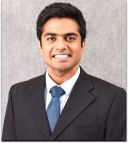How Effective Is Passive Perspiration for Continuous Glucose Monitoring?
Tuesday, March 4, 2025 11:40 AM to 11:50 PM · 12 hr. 10 min. (America/New_York)
Room 107A
Organized Session
Bioanalytical & Life Science
Information
Dynamic and non-invasive blood glucose (BG) monitoring is essential in managing diabetes, where complications can be life-threatening. While microneedles have significantly advanced continuous glucose monitoring (CGM), they remain costly and complex to manufacture. Furthermore, the correlation between glucose concentrations in actively induced sweat (e.g., during exercise or iontophoresis) and blood glucose levels has long been debatable. This talk proposes a novel approach using osmotically derived passive sweat as an alternative to interstitial fluid for continuous, non-invasive glucose monitoring. We developed a wearable, power-free prototype consisting of a hydrogel, fluidic channel, and self-powered glucose sensor. The hydrogel facilitates osmosis when in contact with the skin, allowing sweat to flow through a fluidic channel to the sensor at a rate of ~0.1-0.3 µL/min. This method enables continuous glucose monitoring without the need for external power, making it ideal for integration with low-powered bioelectronics. The prototype was tested on the fingertip and forearm, where sweat glucose levels lagged 15-20 minutes behind blood glucose levels. Personalized calibration models were created for each subject, factoring in the lag time, measured signal, and BG values. Remarkably, the calibration remained valid for up to 90 days with minimal interference from sweat rate fluctuations, reducing the need for frequent blood calibrations. The system demonstrated a mean absolute relative difference (MARD) of ~11% compared to commercial BG monitors based on 300 data points from healthy and diabetic subjects - the lowest error reported under passive perspiration-based monitoring to date. Overall, our passive sweat-based CGM system offers a promising, cost-effective, and non-invasive alternative to current glucose monitoring technologies, potentially shaping the next generation of self-administered diabetes management devices.
Day of Week
Tuesday
Session or Presentation
Presentation
Session Number
OC-14-07
Application
Biomedical
Methodology
Electrochemistry
Primary Focus
Methodology
Morning or Afternoon
Morning
Register
Register Now
